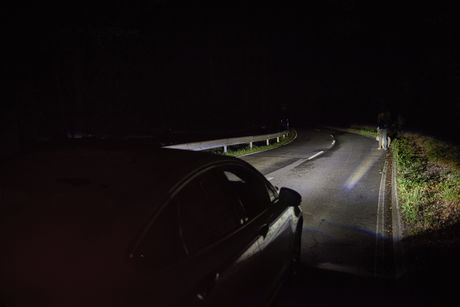'See-through' trucks and cars that see around corners

A number of new camera technologies that aim to improve visibility for drivers may be on their way to market in the not-too-distant future.
The National Road Safety Partnership Program (NRSPP) has reported on new car camera technology being introduced to combat the difficulties associated with blind corners and intersections. Ford motor company is now offering its first-to-market Front Split View Camera as an option on some of its overseas models, with the intention of making the camera globally available by 2020.
The camera displays a 180° view from the front of the car using a video camera attached to the grille. When leaving a driveway or at a blind intersection, the camera enables the driver to easily make out approaching vehicles, pedestrians and cyclists. The 1 megapixel camera displays the full 180° image on the vehicle’s 8″ colour touchscreen. The lens is kept clear via a specially designed retractable jet-washer that is activated whenever the windscreen wipers are in use.
Testing was carried out in all manner of weather conditions, including when full sunlight was shining directly into the camera, to ensure that it would operate as required.
The split view is activated by the driver at the push of a button on the dashboard and it automatically shuts off when vehicle speed reaches 10 kph, much the same as currently available reversing camera technology.
In addition to Ford’s offering, the Argentinian arm of electronics manufacturer Samsung has apparently come up with an idea that seems so simple it makes you wonder why it didn’t happen earlier. Although, the fact that the Korean company’s HQ declined to comment on the development or its commercial viability suggests we may not see this particular technology made available any time soon. The Samsung Safety Truck was all over the news a few months ago, offering a seemingly simple solution to the risks associated with overtaking semitrailers.
The truck was fitted with a front grille-mounted wireless camera and an array of four outdoor television screens on the rear doors. Video taken by the camera is relayed to the screens, offering the driver behind a bird’s-eye view of the conditions ahead of the truck, taking the guesswork out of when best to overtake.
Simple? Yep. Effective? Most definitely. Unrealistic? Probably. The expense associated suggests that it may not become mainstream anytime soon, but it is a pretty straightforward solution. It remains to be seen whether Samsung will comment.
Back to Ford, the company is developing its Camera-Based Advanced Front Lighting System that can widen the headlight beam at junctions and roundabouts to better illuminate hazards that are not in the direction of travel. New Spot Lighting technology helps draw the driver’s attention to pedestrians, cyclists and even large animals in the vehicle’s path or even just off the road.

The system also uses GPS information to better illuminate bends and dips on a chosen route. Where GPS information is not available the technology uses a forward-facing video camera mounted in the rear-view mirror base to detect lane markings and predict the road’s curvature, using the information to illuminate the area more effectively.
In a further evolutionary step, in those instances, the camera stores the information in the navigation system. When next the driver uses the same road again, the headlights adapt to the course of the road automatically to better light the way.
The Camera-Based Advanced Front Lighting System was developed at Ford’s European Research and Innovation Centre in Aachen, Germany, and Ford expects the technology to be available for customers in the near term.
All-electric haulage fleet under mining alliance
A strategic alliance between Newmont and Caterpillar will see the rapid deployment of an...
How to measure ROI of field service management software
Some ROIs are easier to calculate than others. It's important to consider both tangible and...
Preparing the grid for electric vehicles
A new $3.4 million trial will help support growing adoption of electric vehicles across Australia...



